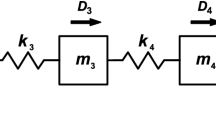Abstract
The present paper describes a solution to a problem of identifying damage in a building based on experimentally measured vibrational eigenvalue and eigenmode pairs. The healthy rate, which is defined as the stiffness rate with respect to a perfect material, is chosen as the design target to be identified. The range of the healthy rate is restricted to within the range of 0–1. In order to overcome this restriction, we define a function with no restriction on the range defined in the domain of a linear elastic body for a building as a design variable and assume that the healthy rate is given by a sigmoid function of the function of the design variable. The linear coupling of the mean squared errors of vibrational eigenvalues and eigenmodes with respect to the measured values are used as a cost function. The derivative of the cost function with respect to the design variable is evaluated by the adjoint variable method. In order to resolve the identification problem of the damaged area, we use an iterative algorithm based on the \(H^{1}\) gradient method using the finite-element method to obtain numerical solutions. A numerical example using experimental data demonstrates that a damaged area can be identified by the proposed approach.










Similar content being viewed by others
References
Aoki, T., Mazzon, N., Valluzzi, M.R., Casarin, F., Modena, C.: Dynamic identification and damage detection of multi-leaf stone masonry building by shaking table test. J. Struct. Eng. Symp. Struct. Eng. Comm. Civ. Eng. Archit. Sci. Counc. Jpn. 56B, 99–105 (2010)
Aoki, T., Minamitani, T., Yuasa, N.: Experimental study on demolition work of buildings of the school of pharmacy, gym of the school of design and architecture in Nagoya City University (in japapnese). Tech. Rep., Japan Demolition Contractors Association (2012)
Aoki, T., Sabia, D.: Structural characterization of a brick chimney by experimental tests and numerical model updating. Mason. Int. 19(2), 41–52 (2006)
Aoki, T., Sabia, D., Rivella, D.: Influence of experimental data and FE model on updating results of a brick chimney. J. Adv. Eng. Softw. Elsevier 39(4), 327–335 (2008)
Aoki, T., Sabia, D., Rivella, D., Komiyama, T.: Structural characterization of Rakanji stone arch bridge by experimental tests and numerical model updating. Int. J. Archit. Herit. Conserv. Anal. Restor. 1(3), 227–250 (2007)
Aoki, T., Yuasa, N., Sabia, D., Rivella, D., Muto, H.: Dynamic identification of the RC building No. 5 of College of Industrial Technology at Nihon University. In: Topping, B.H.V. (ed.) Proceedings of the 10th International Conference on Civil, Structural and Environmental Engineering Computing, Rome, Paper 246 (CD-ROM), pp. 1–14. Civil Comp Press, Stirling (2005)
Azegami, H., Kaizu, S., Takeuchi, K.: Regular solution to topology optimization problems of continua. JSIAM Lett. 3, 1–4 (2011)
Deaton, J.D., Grandhi, R.D.: A survey of structural and multidisciplinary continuum topology optimization: post 2000. Struct. Optim. 49, 1–38 (2014)
Friswell, M.I., Mottershead, J.E.: Finite Element Model Updating in Structural Dynamics. Kluwer Academic Publishers, Dordrecht (1995)
Jung, H., Ewins, D.J.: Error sensitivity of the inverse eigensensitivity method for model updating. In: Proceedings of 10th International Modal Analysis Conference, San Diego, pp. 992–998 (1992)
Kawashima, K., Aydan, O., Aoki, T., Kishimoto, I., Konagai, K., Matsui, T., Sakuta, J., Takahashi, N., Teodori, S.P., Yashima, A.: Reconnaissance investigation on the damage of the 2009 L’Aquila, Central Italy Earthquake. J. Earthq. Eng. 14(6), 817–841 (2010)
Link, M.: Updating of Analytical Models : Review of Numerical Procedures and Application Aspects. Research Studies Press Ltd., Baldock (2001)
Mazzon, N., Valluzzi, M.R., Aoki, T., Garbin, E., De Canio, G., Ranieri, N., Modena, C.: Shaking table tests on two multi-leaf stone masonry buildings. In: Proceedings of the 11th Canadian Masonry Symposium, Toronto, pp. 325–334 (2009)
Sigmund, O., Peterson, P.: Numerical instabilities in topology optimization: a survey on procedures dealing with checkerboards, mesh-dependencies and local minima. Struct. Optim. 16, 68–75 (1998)
Wu, J.R., Li, Q.S.: Finite element model updating for a high-rise structure based on ambient vibration measurements. Eng. Struct. 26, 979–990 (2004)
Author information
Authors and Affiliations
Corresponding author
About this article
Cite this article
Tago, K., Aoki, T. & Azegami, H. Identification of building damage using vibrational eigenvalue and eigenmode pairs. Japan J. Indust. Appl. Math. 32, 297–313 (2015). https://doi.org/10.1007/s13160-015-0180-x
Received:
Revised:
Published:
Issue Date:
DOI: https://doi.org/10.1007/s13160-015-0180-x




